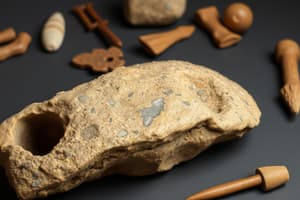Podcast
Questions and Answers
Which of the following best describes the significance of the Neolithic Revolution?
Which of the following best describes the significance of the Neolithic Revolution?
- The rise of nomadic lifestyles.
- The decline of social structures.
- The transition to settled agriculture and domestication of animals. (correct)
- The development of advanced weaponry.
The term 'Neolithic' refers exclusively to the development of new types of metal tools.
The term 'Neolithic' refers exclusively to the development of new types of metal tools.
False (B)
Name two advancements in textile production during the Neolithic period.
Name two advancements in textile production during the Neolithic period.
Huses and looms
The Neolithic period is characterized by a shift towards a more ______ lifestyle, marked by the establishment of permanent settlements.
The Neolithic period is characterized by a shift towards a more ______ lifestyle, marked by the establishment of permanent settlements.
Match the following phrases of the Neolithic period with their time frames:
Match the following phrases of the Neolithic period with their time frames:
Which primary change in Neolithic society led to increased social differentiation and complexity?
Which primary change in Neolithic society led to increased social differentiation and complexity?
Neolithic art was limited exclusively to functional items, with no evidence of ritual or decorative purposes.
Neolithic art was limited exclusively to functional items, with no evidence of ritual or decorative purposes.
What key innovation improved pottery production during the Neolithic period?
What key innovation improved pottery production during the Neolithic period?
The use of ______ for building construction became common during the Neolithic period, allowing for more durable and permanent houses.
The use of ______ for building construction became common during the Neolithic period, allowing for more durable and permanent houses.
What role did the development of ceramics play in Neolithic communities?
What role did the development of ceramics play in Neolithic communities?
Flashcards
What is the Neolithic Period?
What is the Neolithic Period?
The final period of the Prehistory, part of the Stone Age, marked by significant transformations in human life, especially in economy, society, and technology.
Neolithic Initial Phase (I Phase)
Neolithic Initial Phase (I Phase)
Approximately from 7000 BC to 5500 BC. Characterized by the beginning of agriculture and domestication of plants and animals and permanent settlements.
Emergence of Agriculture
Emergence of Agriculture
Marked the first agricultural revolution, with humans cultivating land and selecting plants for consumption, leading to more stable food supply.
Domestication of Animals
Domestication of Animals
Signup and view all the flashcards
Sedentarism
Sedentarism
Signup and view all the flashcards
Demographic Growth
Demographic Growth
Signup and view all the flashcards
Development of Tools and Technology
Development of Tools and Technology
Signup and view all the flashcards
Ceramics in Neolithic Period
Ceramics in Neolithic Period
Signup and view all the flashcards
Textiles in Neolithic Period
Textiles in Neolithic Period
Signup and view all the flashcards
Study Notes
The Neolithic Period
- The Neolithic era is the final period of Prehistory, within the Stone Age.
- It involves significant transformations in human life, especially in economy, society, and technology.
- The word "Neolithic" comes from the Greek words "neo" (new) and "lithos" (stone), translating to "new stone".
- It refers to innovations in the creation of polished stone tools that characterize this period.
- The Neolithic period is dated approximately between 8000 B.C. and 4500 B.C., but dates vary by region.
Neolithic Phases
- The Initial Neolithic phase dates approximately from 7000 B.C. to 5500 B.C.
- Agriculture and the domestication of plants and animals begin during this phase.
- Human communities start to establish permanent settlements.
- The first polished stone tools are developed, leading to a significant shift in lifestyles.
- Hunting and gathering transition to an economy based more on food production.
- The Full Neolithic phase dates from 5500 B.C. to 4000 B.C.
- There's a significant increase in agricultural and livestock production during this phase.
- More advanced techniques for cultivation and animal domestication are developed.
- The first social classes emerge due to population growth and job specialization.
- Villages begin to be constructed more complexly, leading to the emergence of the first civilizations.
- The Final Neolithic phase dates approximately from 4000 B.C. to 3000 B.C.
- The development of pottery, textiles, and other crafts intensifies.
- Architecture becomes more complex, with the construction of permanent structures.
- This period culminates with the emergence of more complex societies that eventually lead to the development of writing and the first civilizations.
Characteristics of the Neolithic Period
- Agriculture marked the first agricultural revolution.
- Humans began cultivating the land and selecting plants for consumption, providing more stable and predictable food.
- Domestication of animals was initiated, leading to development of livestock farming.
- This provided resources such as meat, milk, and other useful materials.
- The transition to an agricultural economy led communities to settle in one location, giving rise to the first towns and villages.
- Increased food production and improved living conditions led to significant population growth, contributing to a more complex society.
- Stone tools were refined, and new technologies like the loom and pottery were developed.
- The invention of the lathe improved pottery production.
- Neolithic art was seen in megalithic constructions and cave paintings that reflected cultural and ritual aspects of these communities.
- Architecture also evolved with the use of adobe for building houses.
Important Advancements
- Pottery was used for storing food and water, essential for agricultural communities.
- Decorated with impressions and encrusted designs, reflecting increasing cultural complexity.
- Spindles and rudimentary looms were used to create fabrics from wool and linen.
- Allowed the creation of clothing and other textile products.
Social Organization
- Leaders or chiefs of the community were initially elected but ended up concentrating power and wealth in specific families.
- Artisans and merchants played more specialized roles.
- Farmers and herders were the most numerous group but were less valued.
Division of Labor
- Men were generally involved in activities like hunting and defense.
- Women initially played a significant role in agricultural production.
- Over time, the role of women was restricted to more domestic and productive tasks like spinning and weaving.
Studying That Suits You
Use AI to generate personalized quizzes and flashcards to suit your learning preferences.




